STIHL HT 75, HT 70 Owner's Manual
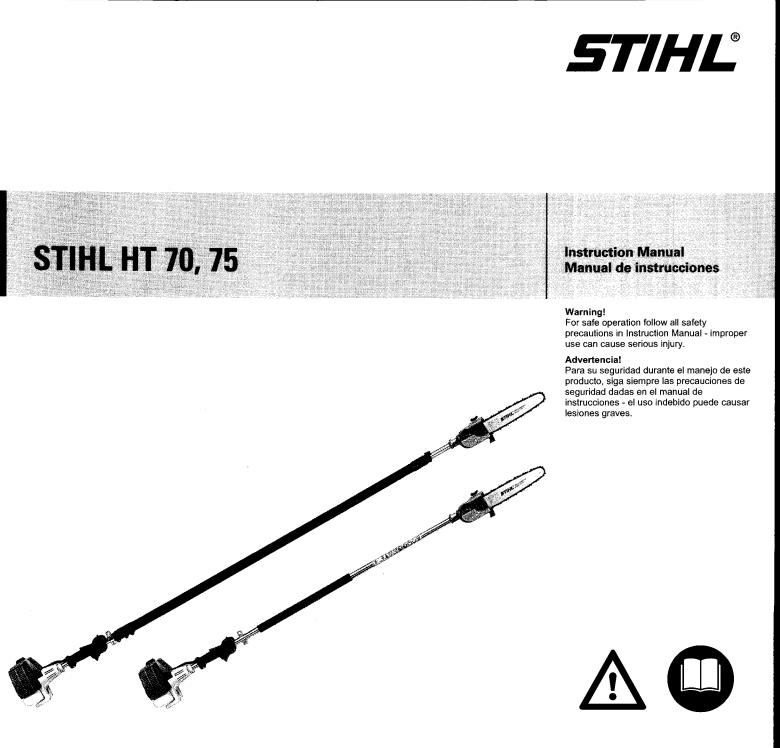
|
|
Contents |
|
|
|
Guide to Using this Manual .............. |
2 |
oils; |
|
|
|
|
|
Safety Precautions ........................... |
3 |
containinksPrintingvegetable |
recycled.becanpaper |
|
|
|
|
Using the Pole Pruner .................... |
13 |
|
|
Mounting the Bar and Chain ........... |
16 |
|
|
Tensioning the Saw Chain .............. |
17 |
|
|
Checking Chain Tension ................. |
17 |
|
|
Adjusting the Throttle |
|
|
|
Cable* ............................................. |
17 |
|
|
Fuel ................................................ |
18 |
|
|
Fueling ............................................ |
19 |
|
|
Chain Oil ......................................... |
20 |
|
|
Filling Chain Oil Tank ...................... |
20 |
|
|
Checking Chain Lubrication ........... |
21 |
|
|
Adjusting Telescopic Shaft .............. |
21 |
|
|
Fitting the Harness ......................... |
22 |
|
|
Starting / Stopping |
|
|
|
the Engine ...................................... |
23 |
paper. |
|
Operating Instructions .................... |
27 |
free |
|
Taking Care of Guide Bar ............... |
28 |
|
|
Cleaning the Air Filter ..................... |
28 |
chlorineon - |
|
Adjusting the Carburetor ................ |
29 |
|
|
Motor Management ........................ |
29 |
|
|
Spark Arresting Screen* in Muffler |
. 31 |
Printed |
|
Checking the Spark Plug ................ |
31 |
|
|
Replacing the Starter Rope |
|
|
|
and Rewind Spring ......................... |
32 |
& Co. KG, 2003 |
PM. Printed in USA |
|
|
AG D3. |
|
|
|
ANDREAS© STIHL |
39004583021. M7. |
STIHl |
|
|
|
* ........see “Guide to Using this Manual“ |
|
Storing the Machine ....................... |
35 |
Checking the Chain Sprocket ......... |
35 |
Replacing Chain Sprocket .............. |
36 |
Maintaining and Sharpening |
|
Saw Chain ...................................... |
36 |
Maintenance Chart ......................... |
41 |
Parts and Controls ......................... |
42 |
Specifications ................................. |
44 |
Special Accessories ....................... |
45 |
Maintenance and Repairs .............. |
45 |
STIHL Incorporated Federal |
|
and California Emission Control |
|
Warranty Statement ........................ |
46 |
english
Allow only persons who understand this manual to operate your pole pruner.
To receive maximum performance and satisfaction from your STIHL pole pruner, it is important that you read and understand the maintenance and safety precautions, starting on page 3, before using your pole pruner.
Contact your STIHL dealer or the STIHL distributor for your area if you do not understand any of the instructions in this manual.
!Warning!
Because a pole pruner is a high-speed cutting tool with a very long reach some special safety precautions must be observed to reduce the risk of personal injury.
Careless or improper use may cause serious or even fatal injury.
STIHL's philosophy is to continually improve all of its products. As a result, engineering changes and improvements are made from time to time. If the operating characteristics or the appearance of your pole pruner differ from those described in this manual, please contact your STIHL dealer for information and assistance.
HT 70, HT 75 |
1 |
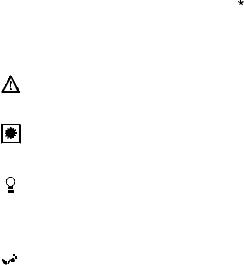
english
Guide to Using this Manual
Pictograms
All the pictograms attached to the machine are shown and explained in this manual.
The operating and handling instructions are supported by illustrations.
Symbols in text
The individual steps or procedures described in the manual may be marked in different ways:
:Step or procedure without direct reference to an illustration.
Description of step or procedure that refers directly to the illustration and contains item numbers that appear in the illustration.
Example:
Loosen the screw (1) Lever (2) ...
In addition to the operating instructions, this manual may contain paragraphs that require your special attention. Such paragraphs are marked with the symbols described below:
Warning where there is a risk of an accident or personal injury or
serious damage to property.
 Warning where there is a risk of damaging the machine or individual components.
Warning where there is a risk of damaging the machine or individual components.


 Note or hint which is not essential for using the machine, but may improve the operator’s understanding of the situation and result in better use of the machine.
Note or hint which is not essential for using the machine, but may improve the operator’s understanding of the situation and result in better use of the machine.

 Note or hint on correct procedure in
Note or hint on correct procedure in 
 order to avoid damage to the environment.
order to avoid damage to the environment.
Equipment and features
This instruction manual refers to several models with different features. Components that are not installed in all models and related applications are marked thus *. Such components are available as special accessories from your STIHL dealer.
Engineering improvements
STIHL’s philosophy is to continually improve all of its products. As a result, engineering changes and improvements are made from time to time. If the operating characteristics or the appearance of your machine differ from those described in this manual, please contact your STIHL dealer for assistance.
Therefore, we cannot be responsible for changes, modifications or improvements not covered in this manual.
2 |
HT 70, HT 75 |
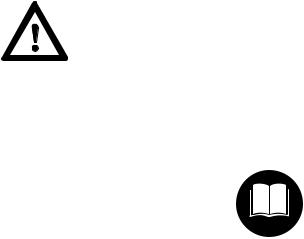
Safety Precautions
The use of any pole pruner may be hazardous. The pole
pruner chain has many sharp cutters. If the cutters contact your flesh,
they will cut you, even if the chain is not moving. At full throttle, the chain speed can reach 68 mph (30 m/s). It is important that you read, fully understand and observe the following safety precautions and warnings. Read the owner's manual and the safety instructions periodically.
All safety precautions that are generally observed when working with an axe or a hand saw also apply to the operation of pole pruners. However, because a pole pruner is a high-speed, fast-cutting power tool with a very long reach, special safety precautions must be observed to reduce the risk of personal injury.
Have your STlHL dealer show you how to operate your pole pruner. Observe all applicable local safety regulations, standards and ordinances.
!Warning!
Minors should never be allowed to use a pole pruner. Bystanders, especially children, and animals should not be allowed in the area where a pole pruner is in use. Never let the pole pruner run unattended.
The pole pruner user is responsible for accidents or risks involving third parties or their property!
Do not lend or rent your pole pruner without the owner's manual. Be sure that anyone using your pole pruner reads and understands the information contained in this manual.
These safety precautions and warnings apply to the use of all STIHL pole pruners. Different models may have different parts and controls. See the appropriate section of your owner's manual for a description of the controls and function of the parts of your model pole pruner.
english
Safe use of a pole pruner involves:
1.the operator
2.the pole pruner
3.the use of the pole pruner
THE OPERATOR
Physical Condition
You must be in good physical condition and mental health and not under the influence of any substance (drugs, alcohol etc.) which might impair vision, dexterity or judgment.
Do not operate a pole pruner when you are fatigued. Be alert – if you get tired while operating your pole pruner, take a break. Tiredness may result in loss of control. Working with any pole pruner can be strenuous. If you lack sufficient strength to maintain control of the pruner, do not use it. If you have any condition that might be aggravated by strenuous work, check with your doctor before operating a pole pruner.
HT 70, HT 75 |
3 |

english
!Warning!
Prolonged use of pole pruners (or other machines) exposing the operator to vibrations may produce whitefinger disease (Raynaud's phenomenon) or carpal tunnel syndrome. These conditions reduce the hand's ability to feel and regulate temperature, produce numbness and burning sensations and may cause nerve and circulation damage and tissue necrosis.
All factors which contribute to whitefinger disease are not known, but cold weather, smoking and diseases or physical conditions that affect blood vessels and blood transport, as well as high vibration levels and long periods of exposure to vibration are mentioned as factors in the development of whitefinger disease. In order to reduce the risk of whitefinger disease and carpal tunnel syndrome, please note the following:
:Most STIHL power tools are available with an anti-vibration ("AV") system designed to reduce the transmission of vibrations created by the engine to the operator's hands. An AV system is recommended for those persons using power tools on a regular or sustained basis.
:Wear gloves and keep your hands warm.
:Keep the AV system well maintained. A pole pruner with loose components or with damaged or worn AV buffers will tend to have higher vibration levels.
:Maintain a firm grip at all times, but do not squeeze the handles with constant, excessive pressures, take frequent breaks.
All the above mentioned precautions do not guarantee that you will not sustain whitefinger disease or carpal tunnel syndrome. Therefore continual and regular users should monitor closely the condition of their hands and fingers. If any of the above symptoms appear, seek medical advice immediately.
!Warning!
The ignition system of your unit produces an electromagnetic field of a very low intensity. This field may interfere with some pacemakers.
To reduce the risk of serious or fatal injury, persons with pacemaker should consult their physician and the pacemaker manufacturer before operating this tool.
Proper Clothing
Clothing must be sturdy and snug-fitting, but allow
complete freedom of movement. Avoid loose-
fitting jackets, scarves, neckties, jewelry, flared or
cuffed pants, or anything that could become entangled with the pruner or brush. Wear overalls or jeans with reinforced cut retardant inserts.
Wear gloves to improve your grip and help protect your hands when handling the pole pruner and saw chain. Heavyduty, nonslip gloves are recommended.
Good footing is most important in pole pruner work. Wear sturdy boots with nonslip soles. Steeltoed safety boots are recommended.
4 |
HT 70, HT 75 |

english
To reduce the risk of injury to your eyes never operate a pole pruner unless wearing goggles or
properly fitted safety glasses with adequate top
and side protection complying with ANSI Z 87.1.
To reduce the risk of injury to your face, STIHL recommends that you also wear a face shield or face screen over your goggles or safety glasses.
Wear an approved safety hard hat to reduce the risk of head injury. Pole pruner noise may damage your hearing. Always wear sound barriers (ear plugs or ear mufflers) to reduce the risk of hearing loss. Continual and regular users should have their hearing checked regularly.
THE POLE PRUNER
For illustrations and definitions of the parts of the pole pruner see the chapter on "Parts and Controls" and "Definitions".
!Warning!
Never modify a pole pruner in any way. Only attachments and parts supplied by STIHL or expressly approved by STIHL for use with the specific STIHL pole pruner models are authorized. Although certain unauthorized attachments are useable with the STIHL powerhead, their use may, in fact, be extremely dangerous.
Use the unit only with the recommended saw chain and guide bar – a longer bar makes the unit difficult to control.
THE USE OF THE UNIT
Transporting the pole pruner
!Warning!
Always stop the engine before putting a pole pruner down or carrying it. Carrying a pole pruner with the engine running is extremely dangerous. Accidental acceleration of the engine can cause the chain to rotate.
!Warning!
During operation, the powerhead muffler and the material around it reach extremely high temperatures. Avoid touching the hot muffler – you could receive serious burns!
390BA000 KN |
By hand: When carrying your pole pruner by hand, the engine must be stopped and the pole pruner must be in the proper position. The chain guard (scabbard) should be over the chain and the guide bar, which should point backwards. When carrying your pole pruner, the bar should be behind you.
By vehicle: When transporting in a vehicle, keep chain and bar covered with the chain guard. Properly secure your pole pruner to prevent turnover, fuel spillage and damage to the pole pruner.
HT 70, HT 75 |
5 |

english
Preparation for the use of the pole pruner
Take off the chain guard and inspect for safety in operation. For assembly, follow the procedure described in the chapter "Mounting the Bar and Chain" of your owner's manual.
STIHL Oilomatic chain, guide bar and sprocket must match each other in gauge and pitch.
!Warning!
Proper chain tension is extremely important. In order to avoid improper setting, the tensioning procedure must be followed as described in your manual. Always make sure the hex nut(s) for the sprocket cover is (are) tightened securely after tensioning the chain.
Never start the pole pruner with the sprocket cover loose. Check chain tension once more after having tightened the nut(s) and thereafter at regular intervals (whenever the pole pruner is shut off). If the chain becomes loose while cutting, shut off the engine and then tighten. Never try to tighten the chain while the engine is running!
Fueling
Your STIHL pole pruner uses an oilgasoline mixture for fuel (see chapter "Fuel" of your owner's manual).
!Warning!
Gasoline is an extremely flammable fuel. If spilled or ignited by a spark or other ignition source, it can cause fire and serious burn injury or property damage. Use extreme caution when handling gasoline or fuel mix.
To reduce the risk of fire or burn injury, do not smoke
while using or standing near the machine. Combustible fuel vapor may escape from the fuel system.
Dust (e.g. wood dust), vapor (e.g. oil mist from the chain lubricating system) and smoke containing chemical substances may be produced when using this machine. These substances may cause serious injuries and health risks such as respiratory illnesses, cancer, genetic defects or hereditary damage.
If the risks associated with the possible dust, vapor and smoke emissions are not known, you should obtain the relevant information from the contractor or the responsible control body.
If it is not possible to avoid considerable amounts of dust, vapor or smoke being generated in spite of using the proper working techniques, it is recommended that the operator and bystanders wear respirators approved for the substances concerned.
Fueling Instructions
Fuel your pole pruner in well-ventilated areas, outdoors only.
Always shut off the engine and allow it to cool before refueling. Gasoline vapor pressure may build up inside the gastank of a two cycle engine depending on the fuel used, the weather conditions, and the venting system of the tank.
6 |
HT 70, HT 75 |

english
In order to reduce the risk of burns or other personal injury from escaping gas vapor and fumes, remove the fuel cap on the STIHL product carefully so as to allow any pressure build-up in the tank to release slowly. Never remove fuel filler cap while engine is running.
Select bare ground for fueling and move at least 10 feet (3 m) from fueling spot before starting the engine. Wipe off any spilled fuel before starting your pole pruner, and check for leakage.
Check for fuel leakage while refueling and during operation. If fuel or oil leakage is found, do not start or run the engine until leak is fixed and spilled fuel has been wiped away. Take care not to get fuel on your clothing. If this happens, change your clothing immediately.
!Warning!
Unit vibrations can cause an improperly tightened
fuel cap to loosen or come
off and spill quantities of
fuel.
In order to reduce risk of fuel spillage and fire, tighten fuel cap by hand with as much force as possible. Check fuel cap periodically for tightness.
Starting
!Warning!
Your pole pruner is a one-person unit. Do not allow other persons to be near the running pole pruner. Keep bystanders at least 15 m (50 ft) away. Start and operate your pole pruner without assistance.
For specific starting instructions, see the appropriate section of the Owner's Manual. Proper starting methods reduce the risk of injury.
390BA022 KN |
Place the pole pruner on firm ground or other solid surface in an open area or in the alternate as shown in the above picture. Maintain a good balance and secure footing.
!Warning!
To reduce the risk of injury from loss of control, be sure that the guide bar and chain are clear of you and all other obstructions and objects, including the ground. When the engine is started, the engine speed with the starting throttle lock engaged will be fast enough for the clutch to engage the sprocket and turn the chain. Never attempt to start the pole pruner when the guide bar is in a cut or kerf.
HT 70, HT 75 |
7 |
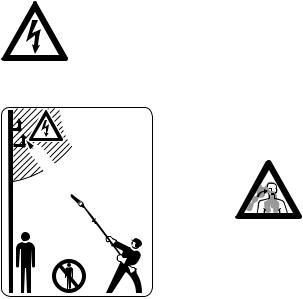
english
When you pull the starter grip, do not wrap the starting rope around your hands. Do not allow the grip to snap back, but guide the starter rope slowly back to permit the rope to rewind properly. Failure to follow this procedure may result in injury to hand or fingers and may damage the starter mechanism.
Important adjustments
!Warning !
To reduce the risk of personal injury from loss of control or contact with the running chain, do not use a pole pruner with incorrect idle adjustment. At correct idle speed, the chain should not rotate.
For directions to adjust idle speed, see the appropriate section of your owner's manual. If you cannot set the correct idle speed, have your STIHL dealer check your pole pruner and make proper adjustments or repairs.
After adjusting chain tension, start the pole pruner, let the engine run for a while, then switch engine off and recheck chain tension. Proper chain tension is very important at all times.
Working Conditions
Danger! Risk of Electrocution!
This pruner is not insulated against electric shock. Approaching or contacting electric power lines with a pruner may cause death by
electrocution or serious bodily injury.
15m
(50ft)
 15m (50ft)
15m (50ft)
Electricity can jump from one point to another by means of arcing. Higher voltage increases the distance electricity can arc. Electricity can also move through branches, especially if they are wet. Maintain a clearance of at least 15 m (50 ft) between the pruner (including any branches it is contacting) and any electrical line carrying live current. Before working with less clearance, contact your electric utility and make sure current is turned off.
!Warning!
The pole pruner has a large range. In order to reduce the risk of personal or even fatal injury to bystanders from falling objects and thrown pieces of wood or in advertent contact with the rotating chain of the pruner always keep bystanders at least 15 m (50 ft) away when the pole pruner is running. Operate your pole pruner only outdoors in a ventilated area.
!Warning!
Your pole pruner produces toxic exhaust
fumes as soon as the combustible engine is running. These gases (e.g. carbon monoxide) may be colorless and odorless.
To reduce the risk of serious or fatal injury from breathing toxic fumes, never run the pole pruner indoors or in poorly ventilated locations.
8 |
HT 70, HT 75 |
english
!Warning!
Use of this product (including sharpening the saw chain) can generate dust, mists and fumes containing chemicals known to cause respiratory disease, cancer, birth defects, or other reproductive harm. If you are unfamiliar with the risks associated with the particular dust, mist or fume at issue, consult your employer, governmental agencies such as OSHA and NIOSH and other sources on hazardous materials. California and some other authorities, for instance, have published lists of substances known to cause cancer, reproductive toxicity, etc. Control dust (such as sawdust), mists (such as oil mist from chain lubrication) and fumes at the source where possible.
In this regard use good work practices and follow the recommendations of OSHA / NIOSH and occupational and trade associations. When the inhalation of toxic dust, mists and fumes cannot be eliminated, the operator and any bystanders should always wear a respirator approved by NIOSH / MSHA for the type substance at issue.
!Warning!
Breathing asbestos dust is dangerous and can cause severe or fatal injury, respiratory illness or cancer. The use and disposal of asbestos containing products have been strictly regulated by OSHA and the Environmental Protection Agency. Do not cut or disturb asbestos, asbestos containing products (e.g. asbestos containing drywall or other construction products), or products such as pipes which are wrapped or covered with asbestos insulation. If you have any reason to believe that you might be cutting asbestos, immediately contact your employer or a local OSHA representative.
!Warning!
The muffler and other parts of the engine (e.g. fins of the cylinder, spark plug) become hot during operation and remain hot for a while after stopping the engine. To reduce risk of burns do not touch the muffler and other parts while they are hot. Operate the pole pruner under good visibility and daylight conditions only. Don't work alone. Keep within calling distance of others in case help is needed.
!Warning!
Take extreme care in wet and freezing weather and in slippery conditions (rain, snow, ice). Put off the work when the weather is windy, stormy or rainfall is heavy.
!Warning!
Avoid stumbling on obstacles such as stumps, roots or rocks and watch out for holes or ditches. Be extremely cautious when working on slopes or uneven ground.
HT 70, HT 75 |
9 |
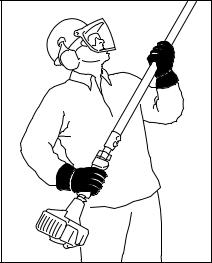
english |
390BA026 KN |
!Warning!
To reduce risk of serious or fatal injury from loss of control of the pole pruner never attempt to operate any pole pruner with one hand. Always hold the pole pruner firmly with both hands.
Wrap your fingers tightly around the control handle and shaft, keeping the handle and shaft between your thumb and forefinger.
Keep your hands in this position to have your pole pruner under control at all times. Make sure the handle and shaft are in good condition and free of moisture, pitch, oil or grease. Place your left hand on front handle and your right hand on rear handle and throttle trigger. Left handers should follow these instructions too.
!Warning!
Do not operate your pole pruner with the starting throttle lock engaged. Cutting with the starting throttle lock engaged does not permit the operator proper control of the pole pruner or chain speed. Always cut at full throttle.
!Warning!
Never touch a chain with your hand or any part of your body when the engine is running, even when the chain is not rotating. The chain continues to rotate for a short period after the throttle trigger is released.
Do not cut any material other than wood or wooden objects. Use your pole pruner for limbing only. It is not designed for felling. It is not designed for prying or shoveling away limbs, roots or other objects.
When limbing, make sure that the saw chain does not touch any foreign materials such as rocks, fences, nails and the like. Such objects may be flung off and injure the operator or bystanders, or damage the saw chain.
!Warning!
In order to keep control of your pole pruner, always maintain a firm foothold. Never work on a ladder, in a tree or on any other insecure support. When working at a height above 4.5 m (15 ft) use a lift bucket.
For pole pruner with adjustable shaft: Expand the shaft only as far as necessary for the intended application.
!Warning!
Don't put pressure on the pole pruner when reaching the end of a cut. The pressure may cause the bar and rotating chain to pop out of the cut or kerf, go out of control and strike the operator or some other object.
!Warning!
Prior to limbing, clear the working area from interfering limbs and brush. Then, establish a path of escape and remove all obstacles.
10 |
HT 70, HT 75 |
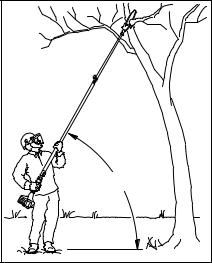
english
max 60° |
390BA025 KN |
Keep work area clear – move away fallen limbs. Place all tools and equipment at a safe distance from the branches being limbed, but not on the escape path.
!Warning!
To reduce the risk of personal or even fatal injury from falling objects do not cut vertically above your body. Hold the pole pruner at an angle of not more than 60° from the horizontal level (see picture). Objects may fall in unexpected directions. Do not stand directly underneath the limb being cut!
Watch for falling wood! As soon as the limbed branch starts to fall, step aside and keep distance away from the falling wood.
!Warning!
Always observe the general condition of the tree. Look for decay and rot in the trunk and branches. If it is rotted inside, it could snap and fall toward the operator while being cut. Also look for broken or dead branches which could vibrate loose and fall on the operator.
If branch is thick or heavy, make a shallow relief cut on the bottom of the branch before cutting down from the top to help prevent splitting of the branch. Always pull the unit out of the cut with the chain running to reduce the possibility of pinching the cutting attachment.
If the bar becomes pinched and caught in the branch so that the chain can no longer move, shut off the pruner and carefully move the branch to open the pinch and release the bar.
MAINTENANCE, REPAIR AND STORING
!Warning!
Maintenance, replacement, or repair of the emission control devices and systems may be performed by any nonroad engine repair establishment or individual. However if you claim warranty for a component which has not been serviced or maintained properly or if nonapproved replacement parts were used, STIHL may deny warranty.
Never operate a pole pruner that is damaged, improperly adjusted or not completely or securely assembled. Follow the maintenance and repair instructions in the appropriate section of your Owner's Manual, especially those in the chapters " Mounting the Bar and Chain" and "Maintaining and Sharpening Saw Chain".
!Warning!
Use only STIHL replacement parts for maintenance and repair. Use of parts manufactured by others may cause serious or fatal injury.
HT 70, HT 75 |
11 |
english
!Warning!
Always shut off the engine and ensure that the chain is stopped before undertaking any adjustments, maintenance or repair work, changing the saw chain or cleaning the pole pruner. Do not attempt any maintenance or repair work not described in your Owner's Manual. Have such work performed at your STIHL service shop only.
!Warning!
Never test the ignition system with ignition wire terminal removed from spark plug or with unseated spark plug, since uncontained sparking may cause a fire.
!Warning!
To reduce the risk of fire and burn injury, use only spark plugs authorized by STIHL. Always press spark plug boot snugly onto spark plug boot of the proper size. (Note: If terminal has detachable SAE adapter nut, it must be attached.)
A loose connection between spark plug boot and ignition wire connector in the boot may create arcing that could ignite combustible fumes and cause a fire. Keep spark plug clean, and make sure ignition lead is in good condition.
!Warning!
Do not operate your pole pruner if the muffler is damaged, missing or modified. An improperly maintained muffler will increase the risk of fire and hearing loss. Never touch a hot muffler or burn will result. If your muffler was equipped with a spark-arresting screen to reduce the risk of fire (e. g. in the USA, Canada and Australia), never operate your pole pruner if the screen is missing or damaged. Remember that the risk of forest fires is greater in hot or dry weather.
Keep the chain, bar and sprocket clean; replace worn sprockets or chains. Keep the chain sharp. You can spot a dull chain when easy-to-cut wood becomes hard to cut or burn marks appear on the wood.
Keep the chain at proper tension. Tighten all nuts, bolts and screws except the carburetor adjustment screws before each use.
Additionally, the daily maintenance schedule for your pole pruner set forth in your STIHL Owner's Manual should be strictly followed.
Store pole pruner in a dry place and away from children. Before storing for longer than a few days, always empty the fuel tank.
For any maintenance please refer to the maintenance chart and to the warranty statement near the end of this manual.
Store fuel and chain oil in approved and properly labeled safety-type canisters only. Take care when handling gasoline! Avoid direct contact with the skin and avoid inhaling fuel vapor!
12 |
HT 70, HT 75 |
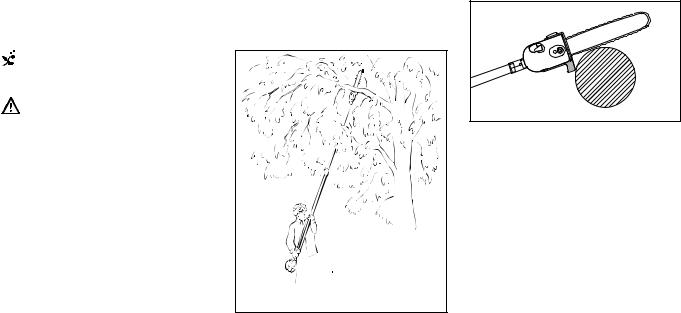
Using the Pole Pruner
Preparations
:Wear suitable protective clothing and equipment – see chapter "Safety Precautions".
:Adjust telescopic shaft to the required length (HT 75 only).
:Start the engine.
:Put on the shoulder strap.

 Never throw cuttings into the
Never throw cuttings into the
household garbage can – cuttings can be composted.
Never stand directly underneath the branch you are cutting – be wary of falling branches. Note that a branch may spring back at you after it hits the ground.
Cutting sequence
To allow branches a free fall, always cut the lower branches first. Prune heavy branches (large diameter) in several controllable pieces.
Working techniques
Hold the control handle with your right hand, and the shaft with your left hand. Your left arm should be extended to the most comfortable position.
HT 70:
Always hold the shaft with your left hand in the area of the handle hose.

















 390BA018 KN
390BA018 KN
The shaft should always be held at an angle of 60° or less.
english
The most convenient working position is a tool angle of 60°, but any lesser angle may be used to suit the situation concerned.
Cross-cut
390BA052 KN
Position the cutting attachment with the hook against the branch and then perform the cross-cut.
HT 70, HT 75 |
13 |
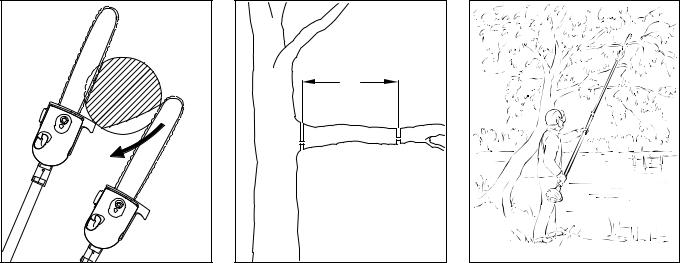
english
2
1
390BA041 KN
Relieving cut
:To avoid kickback, pinching the bar or tearing the bark when pruning thick branches, always start by performing a relieving cut (1) on the underside of the branch.
:To do this, apply the cutting attachment and pull it across the bottom of the branch as far as the bar nose.
:Locate the hook against the branch and then perform the cross-cut (2).
A
4 3
390BA024 KN
Flush-cutting thick branches
:If branch diameter is more than 4“ (10cm), first perform undercut (3) and then cross-cut at a distance of about 8“ (20cm) (A) from the final cut.
Then carry out the flush-cut (4), starting with a relieving cut and finishing with a cross-cut.
390BA020 KN |
Cutting above obstacles
The unit's long reach makes it possible to prune branches that are overhanging obstacles, such as rivers or lakes. The tool angle in this case depends on the position of the branch.
14 |
HT 70, HT 75 |
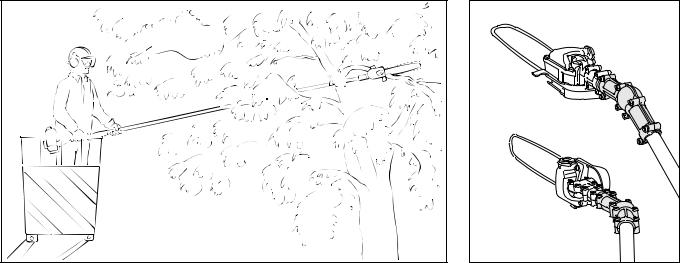
english
390BA017 KN |
Cutting from a lift bucket
The unit's long reach enables cutting to be performed next to the trunk without the risk of the lift bucket damaging other branches. The tool angle depends on the position of the branch.
1
2
390BA053 KN
30° angle drive
(special accessory for HT 70)
The angle drive keeps the cutting attachment at an angle of 30° to the drive tube.
The angle drive may be adjusted on the drive tube to the following positions only:
1:For cross-cutting vertical branches and bushes.
2:For a better view of the cutting attachment.
HT 70, HT 75 |
15 |
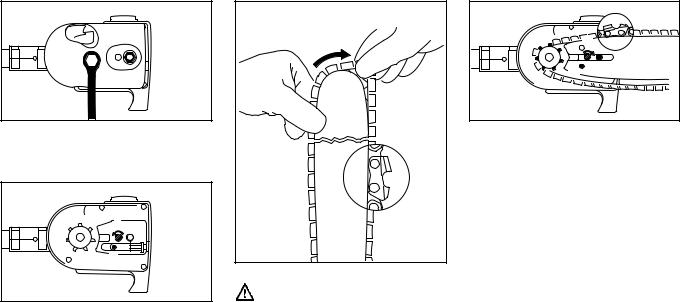
english
Mounting the Bar and Chain
390BA042 KN
:Unscrew nut and take off cover.
1
2 |
KN |
|
390BA043 |
:Turn tensioning screw (1) counterclockwise until the tensioning nut (2) butts against the left end of the housing slot, then back it off 5 full turns.
|
|
5 |
1 |
|
|
|
|
|
|
4 |
3 |
|
|
|
390BA044KN |
|
: Fit guide bar over the stud (3). |
||
|
|
Engage peg of tensioner slide in |
|
|
|
locating hole (4) – place the chain |
|
|
|
over sprocket (5) at the same time. |
|
KN |
: |
Now turn tensioning screw (1) |
|
|
clockwise until there is very little |
||
390BA003 |
|
||
|
chain sag on the underside of the |
||
|
|
||
|
|
bar – and the drive link tangs are |
|
|
|
located in the bar groove. |
|
The chain is very sharp – wear work |
: |
Refit the sprocket cover and screw |
|
on the nut only fingertight. |
|
gloves to protect hands from cuts. |
|
|
|
Now refer to "Tensioning the Saw |
|
: Fit the chain – |
: |
|
|
Chain". |
|
start at the bar nose. |
|
|
|
|
16 |
HT 70, HT 75 |
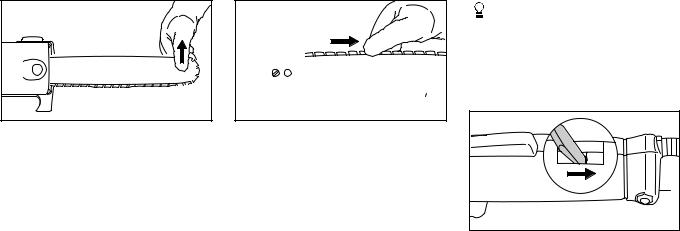
english
Tensioning the Saw Chain |
Checking Chain Tension |
Adjusting the Throttle |
|
|
Cable* |
1


 KN390BA045
KN390BA045
Retensioning during cutting work:
:Shut off the engine and then slacken the nut.
:Hold the bar nose up.
:Use screwdriver to turn the tensioning screw (1) clockwise until chain fits snugly against the underside of the bar.
Tighten down the nut firmly.
A new chain has to be retensioned more often than one that has been in use for some time – check chain tension frequently – see chapter "Operating Instructions / During Operation“.
:Check chain tension.
 390BA046 KN
390BA046 KN
:Shut down the engine.
:Wear work gloves to protect hands.
:Chain must fit snugly against the underside of the bar and it must still be possible to pull the chain along the bar by hand.
:If necessary, retension the chain.
A new chain has to be retensioned more often than one that has been in use for some time.
Check chain tension frequently – see chapter "Operating Instructions / During Operation“.


 A properly adjusted throttle cable is the precondition for correct operation in the full throttle, starting throttle and idle positions.
A properly adjusted throttle cable is the precondition for correct operation in the full throttle, starting throttle and idle positions.
Adjust the throttle cable only after the unit is fully assembled.
002BA163 KN
:Use a suitable tool to push the slide to the bottom of the slot (see illustration).
*see "Guide to Using this Manual"
HT 70, HT 75 |
17 |
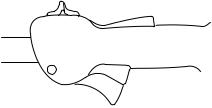
english
1
|
KN |
2 |
002BA161 |
|
:Press down the trigger interlock (1) and squeeze the throttle trigger (2) (full throttle) – this sets the throttle cable correctly.
Fuel
This engine is certified to operate on unleaded gasoline and the STIHL twostroke engine oil at a mix ratio of 50:1.
Your two-stroke engine requires a mixture of brand-name gasoline and quality two-stroke air cooled engine oil.
Use mid-grade unleaded gasoline with a minimum octane rating of 89 (R+M/2). If the octane rating of the mid-grade gasoline in your area is lower, use premium unleaded fuel.
Fuel with a lower octane rating may increase engine temperatures. This, in turn, increases the risk of piston seizure and damage to the engine.
The chemical composition of the fuel is also important. Some fuel additives not only detrimentally affect elastomers (carburetor diaphragms, oil seals, fuel lines, etc.), but magnesium castings and catalytic converters as well. This could cause running problems or even damage the engine. For this reason STIHL recommends that you use only nationally recognized name brand unleaded gasoline!
Use only STIHL two-stroke engine oil or equivalent branded two-stroke engine oils that are designed for use only in air cooled two-cycle engines.
We recommend STIHL 50:1 two-stroke engine oil since it is specially formulated for use in STlHL engines.
Do not use BIA or TCW rated (twostroke water cooled) mix oils or other mix oils that state they are for use in both water cooled and air cooled engines (e.g., outboard motors, snowmobiles, chain saws, mopeds, etc.).
Take care when handling gasoline. Avoid direct contact with the skin and avoid inhaling fuel vapor. When filling at the pump, first remove the canister from your vehicle and place the canister on the ground before filling. Do not fill fuel canisters that are sitting in or on a vehicle.
The canister should be kept tightly closed in order to avoid any moisture getting into the mixture.
The machine‘s fuel tank and the canister in which fuel mix is stored should be cleaned as necessary.
18 |
HT 70, HT 75 |
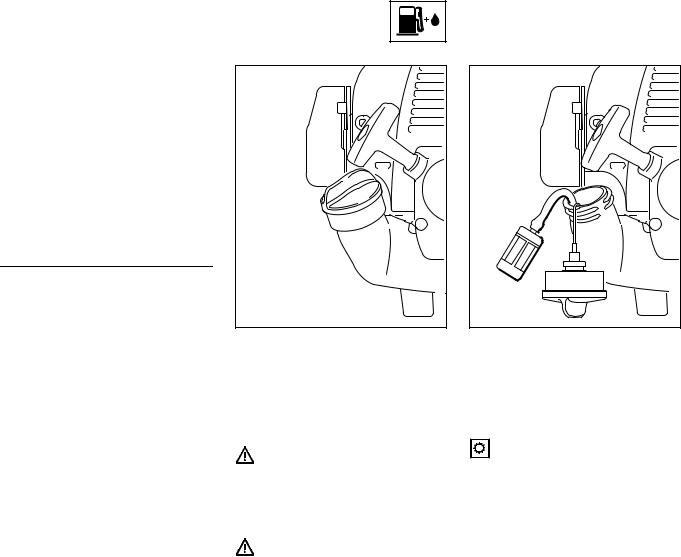
Fueling
Fuel mix ages
Only mix sufficient fuel for a few days work, not to exceed 3 months of storage. Store in approved fuel-canisters only. When mixing, pour oil into the canister first, and then add gasoline. Close the canister and shake it vigorously by hand to ensure proper mixing of the oil with the fuel.
Gaso- |
Oil (STIHL 50:1 or |
|
|
line |
equivalent branded oils) |
|
|
US gal. |
US fl.oz |
|
|
1 |
2.6 |
KN |
|
2 1/2 |
6.4 |
||
389BA031 |
|||
5 |
12.8 |
||
|
Dispose of empty mixing-oil canisters only at authorized disposal locations.
Before fueling, clean the filler cap and the area around it to ensure that no dirt falls into the tank.
Always thoroughly shake the mixture in the canister before fueling your machine.
In order to reduce the risk of burns or other personal injury from
escaping gas vapor and fumes, remove the fuel filler cap carefully so as to allow any pressure build-up in the tank to release slowly.
After fueling, tighten fuel cap
as securely as possible by hand.
english |
389BA032 KN |
Change the fuel pick up body every year.
Before storing your machine for a long period, drain and clean the fuel tank and run engine until carburetor is dry.
Checking oil level
 Check chain oil level in tank at regular short intervals and fill up as necessary.
Check chain oil level in tank at regular short intervals and fill up as necessary.
HT 70, HT 75 |
19 |

english |
|
Chain Oil |
Filling Chain Oil |
|
Tank |

 For automatic and reliable
For automatic and reliable
lubrication of the chain and guide bar: Use only a quality, environmentally compatible chain and bar lubricant. STIHL chain lubricant with non-fling additive or the rapidly biodegradable STIHL BioPlus is recommended.
 Biological chain oil must be resistant to aging (e.g. STIHL BioPlus) since it will otherwise quickly turn to resin. This results in hard deposits that are difficult to remove, especially in the area of the chain drive and chain. It may even cause the oil pump to seize.
Biological chain oil must be resistant to aging (e.g. STIHL BioPlus) since it will otherwise quickly turn to resin. This results in hard deposits that are difficult to remove, especially in the area of the chain drive and chain. It may even cause the oil pump to seize.
The service life of the chain and guide bar depends on the quality of the lubricant. It is therefore essential to use only a specially formulated chain lubricant!
If special chain lubricant is not available, you may – in an emergency – use an HD single grade or multigrade engine oil with a viscosity that suits the prevailing outside temperature.
 Do not use waste oil! Waste oil does not have the required lubricating properties and is unsuitable for chain lubrication.
Do not use waste oil! Waste oil does not have the required lubricating properties and is unsuitable for chain lubrication.
Medical studies have shown that renewed contact with waste oil can cause skin cancer. It also harms the environment!
390BA047 KN |
A full chain oil tank is sufficient for about one tankful of fuel. Check the oil level regularly during cutting work. Never allow the oil tank to run dry!
:Thoroughly clean the filler cap and area around it so that no dirt can fall into the tank.
:Position the unit so that the filler cap faces up.
If the oil level in the tank does not change, this may be due to a problem in the oil supply: Check chain lubrication, clean the oilways, contact your STlHL dealer for assistance if necessary.
20 |
HT 70, HT 75 |
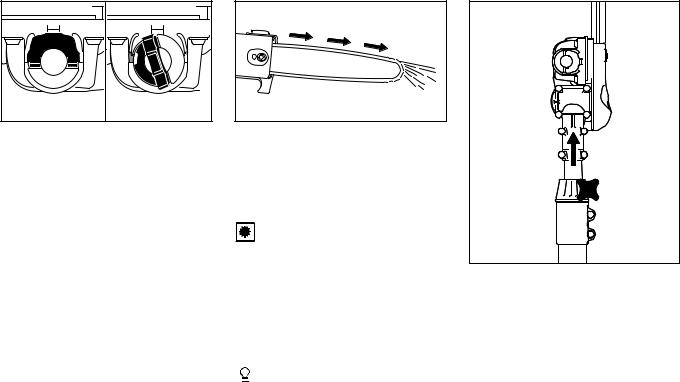
english
Checking Chain Lubrication Adjusting Telescopic Shaft
(HT 75)
1 |
2 |
|
247BA011 KN |
The bayonet-type oil tank filler cap with its hinged clip can be opened and closed without tools.
:To open the tank, swing the clip (1) to the vertical position.
:Turn the filler cap counterclockwise as far as stop and remove.
:Fill up with chain oil.
:To close the oil tank, place the filler cap in position with the clip vertical, making sure the recesses (2) are in alignment.
:Turn the filler cap clockwise as far as stop.
:Fold the clip down so that it is flush with the top of the cap.


 390BA048 KN
390BA048 KN
The saw chain must always throw off a small amount of oil.
:Always check chain lubrication and the oil level in the tank before starting work.
 Never operate your pruner without chain lubrication. If the chain is run dry, the whole cutting attachment will be irretrievably damaged within a very short time.
Never operate your pruner without chain lubrication. If the chain is run dry, the whole cutting attachment will be irretrievably damaged within a very short time.
Inadequate lubrication can be caused by a dirty oil strainer: Have the oil strainer cleaned or replaced by your STIHL dealer.


 Every new chain has to be broken in for about 2 to 3 minutes.
Every new chain has to be broken in for about 2 to 3 minutes.
After breaking in the chain, check chain tension and adjust if necessary – see chapter "Checking Chain Tension".
390BA049 KN
Always shut down the engine and put on the chain guard!
:Slacken off the screw.
:Adjust shaft to required length.
:Tighten the screw firmly.
HT 70, HT 75 |
21 |
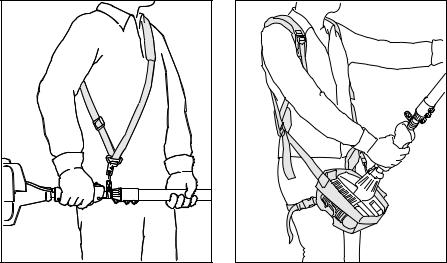
english
Fitting the Harness
1 |
2 |
390BA040 KN |
Shoulder strap*
:Put on the shoulder strap (1).
:Adjust length of strap so that the spring hook (2), with the unit attached, is at about the same height as your right hip.
1 |
2 |
3 |
386BA012KN |
Full harness*
:Put on the full harness (1) and sling (2) as shown on the instruction sheet supplied.
:Adjust the harness and thigh belt (3) as required.
:Rest the powerhead in the sling during cutting work.
* see “Guide to Using this Manual“ |
*see “Guide to Using this Manual” |
22 |
HT 70, HT 75 |
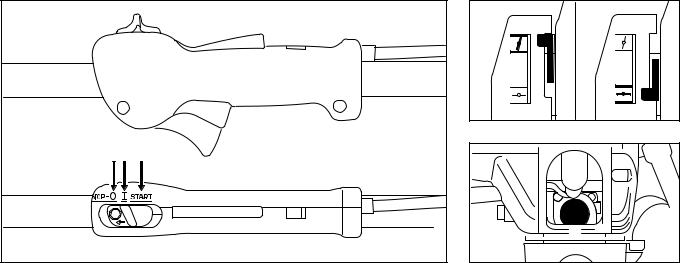
english
Starting / Stopping the Engine
|
|
3 |
1 |
|
|
|
|
|
|
|
2 |
65 4 |
|
|
|
STOP |
3 |
|
KN |
|
|
|
002BA149 |
Controls |
|
|
Starting |
Throttle trigger interlock (1), throttle trigger (2) and slide control (3) with the positions:
START (4)
The normal run position # (5) and
$ – STOP (6) for stopping the engine..
:Hold down the trigger interlock and squeeze the throttle trigger.
:Keep both levers in that position.
:Move the slide control to START position and hold it there.
:Now release the throttle trigger, slide control and trigger interlock in that order. This is the starting-throttle position.
8
8 |
393BA017 KN |
|
KN |
9 |
393BA018 |
|
If engine is cold:
Set the choke lever (8) to g
If engine is warm:
Set the choke lever (8) to e
Also use this setting if engine has been running but is still cold.
:Press the fuel pump bulb (9) at least five times, even if the bulb is still filled with fuel.
HT 70, HT 75 |
23 |
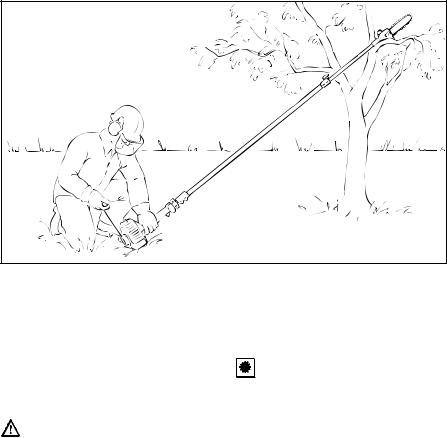
english |
390BA022 KN |
:Place the unit on the ground:
It must rest securely on the engine support and the hook.
:Remove the chain guard.
Check that chain is not touching any object or the ground.
If necessary, rest the hook on a raised support (e.g. a branch, mound or something similar).
Check that nobody is standing within the working range of the pruner.
:Make sure you have a firm footing: Press the unit firmly against the ground with your left hand on the fan housing. Your thumb should be under the fan housing.
 Do not stand or kneel on the drive tube. This will bend the tube
Do not stand or kneel on the drive tube. This will bend the tube
and result in permanent damage to the telescopic shaft.
.
24 |
HT 70, HT 75 |
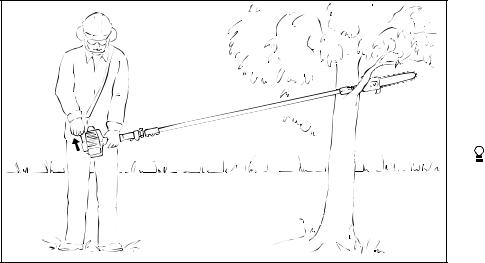
english
390BA009 KN
Alternative method:
:Remove the chain guard. Position the shaft on a branch so that it is held by the hook.
:Hold the unit firmly with your left hand around the fan housing – your thumb under the fan housing.
:Pull the starter grip slowly with your right hand until you feel it engage – and then give it a brisk strong pull. Do not pull out starter rope to full length – it might break.
:Do not let the starter grip snap back
– guide it slowly into the housing so that the starter rope can rewind properly.
When engine begins to fire:
:Move choke lever to e
:continue cranking.
As soon as engine runs:
:Blip the throttle trigger – the slide control moves to the run position #, and the engine returns to idling speed.


 Make sure carburetor is correctly adjusted – chain must not run when engine is idling.
Make sure carburetor is correctly adjusted – chain must not run when engine is idling.
Your pruner is ready for operation.
To shut down engine:
:Move the slide control in direction of cto $.
HT 70, HT 75 |
25 |
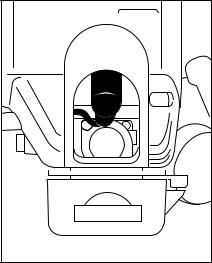
english
At very low temperatures
As soon as engine runs:
:Blip the throttle trigger – the slide control moves to the run position #, and the engine returns to idling speed.
:Open throttle slightly – warm up engine for short period.
If the engine does not start
If you did not move the choke to e quickly enough after the engine began to fire, the combustion chamber is flooded.
:Set choke lever to e.
:Set slide control, interlock lever and throttle trigger to starting throttle position.
:Start the engine – pull the starter rope briskly – 10 to 20 pulls may be necessary.
10 |
393BA019 KN |
If the engine still does not start
:Move the slide control in direction of c to STOP – $.
:Pull off the spark plug boot (10).
:Unscrew and dry off the spark plug.
:Open the throttle fully.
:Pull the starter rope several times to clear the combustion chamber.
:Fit the spark plug – use combination wrench to tighten it down.
:Connect the spark plug boot and press it down firmly.
:Move the slide control to START.
:Set choke lever to e even if engine is cold.
:Now start the engine.
Throttle cable
Check adjustment of the throttle cable – see "Adjusting the Throttle Cable".
Fuel tank run until dry
:After refueling, press the fuel pump bulb at least fives times – even if the bulb is filled with fuel.
:Set choke lever to suit engine temperatire.
:Now start the engine.
26 |
HT 70, HT 75 |

Operating Instructions
During break-in period
A factory new machine should not be run at high revs (full throttle off load) for the first three tank fillings. This avoids unnecessary high loads during the break-in period. As all moving parts have to bed in during the break-in period, the frictional resistances in the engine are greater during this period. The engine develops its maximum power after about 5 to 15 tank fillings.
 Do not make the mixture leaner to achieve an apparent increase in power – this could damage the engine – see chapter “Adjusting the Carburetor”.
Do not make the mixture leaner to achieve an apparent increase in power – this could damage the engine – see chapter “Adjusting the Carburetor”.
During operation
Check chain tension frequently!
A new chain has to be tensioned more often than one that has been in use for some time.
english
Cold chain
Tension is correct when the chain fits snugly against the underside of the bar and can still be pulled along the bar by hand.
Retension if necessary –
see chapter “Tensioning the Saw Chain”.
Chain at operating temperature
The chain stretches and begins to sag. The drive links on the underside of the bar must not come out of the bar groove
– the chain may otherwise jump off the bar.
Retension the chain –
see chapter “Tensioning the Saw Chain”.
 Always slacken off the chain again after finishing work. The chain contracts as it cools down. If it is not slackened off, it may damage the crankshaft and bearings.
Always slacken off the chain again after finishing work. The chain contracts as it cools down. If it is not slackened off, it may damage the crankshaft and bearings.
After a long period of full-throttle operation
Allow engine to run for a while at idle speed so that the heat in the engine can be dissipated by flow of cooling air. This protects engine-mounted components (ignition, carburetor) from thermal overload.
After finishing work
:Slacken off the chain if you have retensioned it at operating temperature during cutting work.
The chain contracts as it cools down. If it is not slackened off, it may damage the crankshaft and bearings.
Wait for engine to cool down. Drain the fuel tank. Store the machine in a dry place. Check tightness of nuts and screws (not adjusting screws) at regular intervals and retighten as necessary.
HT 70, HT 75 |
27 |
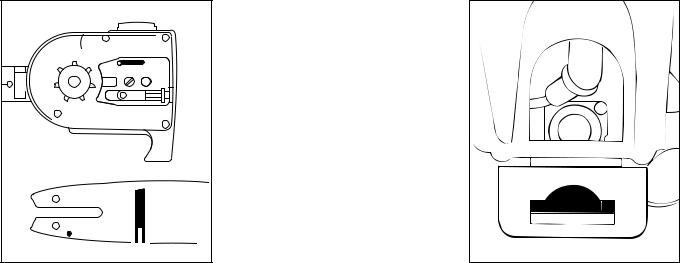
english |
|
Taking Care of Guide Bar |
Cleaning the Air Filter |
|
2 |
|
|
1 |
3 |
KN |
|
390BA050 |
|||
|
|
:Turn the bar over –
every time you sharpen the chain – and every time you replace the chain – this avoids one-sided wear, especiallly at nose and underside of the bar.
Regularly clean 1 = oil inlet hole
2 = oil passage
3 = bar groove
:Measure groove depth –
with scale on filing gauge – see “Special Accessories“ – in area used most for cutting on Rollomatic bars.
Chain type |
Chain pitch |
Minimum |
|
|
|
|
groove depth |
|
Picco-Mini |
3/8" P |
5.0 mm |
|
|
|
(0.20") |
If groove depth is less than specified:
:Replace the guide bar.
The drive link tangs will otherwise scrape along the bottom of the groove – the cutters and tie straps will not ride on the rails.
|
2 |
|
1 |
KN |
|
355BA014 |
||
|
Dirty air filters reduce engine power increase fuel consumption and make starting more difficult.
If there is a noticeable loss of engine power
:Move choke lever to g.
:Press in the tab (1).
:Ease the filter cover (2) over the tab and take it away.
:Clean away loose dirt from around the filter.
:Remove the foam and felt filter elements.
28 |
HT 70, HT 75 |

2
3
4 |
5 |
355BA031 KN
355BA032 KN
|
english |
Motor Management |
Adjusting the Carburetor |
Exhaust emissions are controlled by the design of the fundamental engine parameters and components (e.g. carburation, ignition, timing and valve or port timing) without the addition of any major hardware.
H |
L |
3 / 4 |
1 |
|
LA |
|
265BA024 KN |
:Wash the foam element in a clean, non-flammable cleaning solution (e.g. warm soapy water) and then dry.
:Fit new felt element.
As a temporary measure you can knock it out on the palm of your hand or blow it out with compressed air. Do not wash.
Replace damaged parts!
:Install the foam element (3) in the filter cover (2).
:Place felt element (4) (lettering facing inward) in filter housing (5).
:Fit filter cover so that it snaps into position.
The carburetor comes from the factory with a standard setting.
This setting provides an optimum fuel-air mixture under most operating conditions.
With this carburetor it is only possibleto adjust the engine idle speed within fine limits.
HT 70, HT 75 |
29 |
